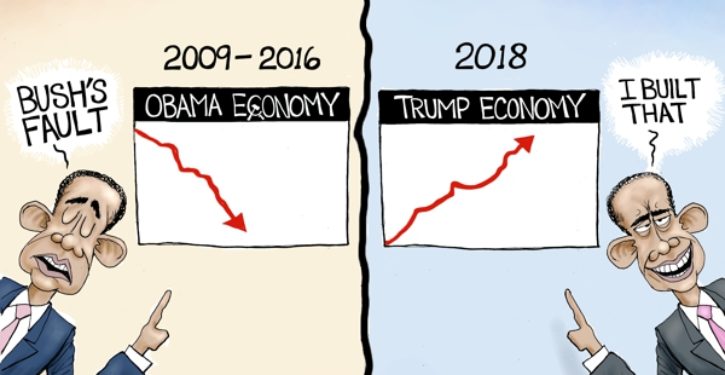
Unemployment is at a 49-year low. American workers are seeing the fastest wage growth in a decade, outpacing inflation. Employers added 263,000 jobs in April.
Trump administration officials say the job market’s gains are a result of the president’s tax cuts and deregulatory policies. “We have entered a very strong and durable prosperity cycle,” said Larry Kudlow, director of the White House’s National Economic Council.
The unemployment rate for women has fallen to 3.1%, the lowest point since 1953. The rate for Hispanics dropped to 4.2%, a record low. The unemployment rate for veterans of the Iraq and Afghan wars dropped to 1.7%, also a record low.
Will this presidential election be the most important in American history?
During the Obama administration, the economy barely grew, rising at an average annual rate of less than 2 percent. As economists such as Mark Perry noted, “During Obama’s time in office, America has slipped in several international rankings of competitiveness, innovation and economic freedom.”
Under the Trump administration, things improved. As Perry, an economics professor in Michigan, points out, median household income in the U.S. is now at an all-time high, although certain regions in the U.S. have lagged behind.
The Trump administration has helped fuel economic growth by bringing an end to the flood of red tape issued by the Obama administration. It has pruned unnecessary regulations more vigorously than any president since Reagan. Over “1,500 Obama rules in the pipeline but not finalized were withdrawn or delayed.” The Competitive Enterprise Institute says cutting red tape helps “consumers, businesses and the economy.” That’s because red tape costs the economy “$2 trillion annually. This amounts to a hidden tax of nearly $15,000 per household in a given year.”
The Trump administration needs to hire more experts to identify harmful regulations, and help agencies publicly explain why they are harmful. During the Trump administration, judges have issued many rulings blocking agency delays of Obama-era regulations. Sometimes, these rulings have been due to judges being hostile — most of the rulings were issued by judges appointed by Obama and Clinton, who sometimes strain to find reasons to rule against the administration. But other times, the Trump administration lost in court due to an agency’s failure to explain adequately why it delayed a regulation, and what harms it might cause. When an agency changes or repeals a regulation, it has to explain its action fully in the Federal Register, including addressing counterarguments against its action. The administration has not hired enough experts who are sympathetic to deregulation to do this adequately in some cases.
Trump also needs to appoint more judges who are willing to allow agencies to delay or swiftly repeal harmful regulations. Judges appointed by Obama and Clinton have been much more likely than judges appointed by Republican presidents to uphold its delays or repeals of Obama-era rules. Appointing more conservative judges will improve the Trump administration’s win-loss record in court.
While federal regulatory policy is no longer dampening the economy as much, many state and local governments are doing things that will reduce job growth in the future. Several states have passed laws increasing the minimum wage over the next several years to $15. That is an excessive level for rural areas with low living costs, where the average worker makes less than $15 per hour today, and two people making $12 per hour can raise a family. A business operating on a thin margin can’t raise all of its employees’ wages — including unskilled entry-level workers — to a level above the regional average. It will end up shutting down, or laying off some of its workers, if the minimum wage is raised to $15. Even in costly urban areas, a $15 minimum wage can be excessive for entry-level workers who don’t provide that much value to an employer, because they are still learning the ropes. Better an entry-level job at only $12 per hour that lets you learn the ropes than no job at all.
Minimum wage hikes to $15 wipe out jobs even in high-income areas. New York City experienced its worst decline in restaurant jobs since 9/11 after a $15 minimum wage there was enacted. Its 40 percent increase in the minimum wage was phased in over a two-year period, but substantial job losses have already occurred. Illinois’ minimum wage increase will be phased in over several years, but some businesses are already closing in anticipation of increased costs.
Most economists say that a $15 minimum wage is a bad idea that will drive up unemployment. For example, an economist at Moody’s calculated that up to 160,000 jobs will be lost in California’s manufacturing sector alone from the increase to $15.
States have also reduced economic growth by imposing ever-expanding occupational licensing regulations, which require people to get a costly license just to perform an ordinary job. Occupational licensing expanded from covering 5 percent of the workforce in the 1950s to 30 percent today. Now, many people are required to get a license just to cut someone’s hair, be an interior designer, or be a tour guide. Such regulations increase costs to consumers and are usually unnecessary. They have spread to the point that they were criticized by officials in both the Obama and Trump administrations.
During the Obama administration, the Department of Labor and the White House Council of Economic Advisers published a lengthy report on licensing laws, and called for states to take action to remove unnecessary barriers to work. “Licensing restrictions cost millions of jobs nationwide and raise consumer expenses by over one hundred billion dollars,’ it concluded. The Institute for Justice estimates that licensing costs the U.S. economy at least 1.8 million jobs and at least $183.9 billion each year in wasted resources and lost output. In 2017, the current Labor Secretary, Alex Acosta, decried the harm of excessive occupational licensing in a speech to state legislators.
A few states such as Idaho and Arizona have listened, and loosened their restrictions. Arizona recently became the first state to recognize occupational licenses from every state. Its governor, Doug Ducey, told reporters, “You don’t lose your skills simply because you pack up a U-Haul truck and make the decision to move to Arizona.”
But most other states, such as California, have resisted reform. As Steven Greenhut of the R Street Institute notes:
California imposes onerous occupational-licensing rules. If you want to do anything beyond, say, working in a fast-food job, you’ve got to get permission from the state.
The average cost of a license is $500, which isn’t insurmountable. But paying Caesar is the easy part. The myriad training rules are the main problem. Last year, Sen. Mike Morrell (R–Rancho Cucamonga) introduced a bill (which my employer sponsored) to eliminate the 1,500 hours in schooling required to shampoo and curl people’s hair for pay. It costs thousands of dollars to get a barbering and cosmetology degree.
That modest bill died in the Assembly.




